Choosing the right Digital Adoption Platform (DAP) is key to ensuring smooth operations and achieving optimal user experiences. This article provides an in-depth comparison between two leading platforms in the DAP space: WalkMe and Pendo.
These platforms are compared across various parameters including advanced automation, customer experience, enterprise readiness, customer support, pricing structure, and unique advantages. As the field continues to evolve, and these platforms roll out new features and enhancements, it is important to note that this page will be updated regularly to reflect the most current information.
Both WalkMe and Pendo are well received by users and industry analysts. But not all DAP solutions were created equal. So, how can you know which is right for you? The first step would be to outline your objectives and priorities beyond the need to streamline onboarding and training with walkthroughs.
This may include accessing user behavior insights, automating tasks, applying cross-app analytics, and optimizing software licensing, among others.
Once you’ve got your list in hand, a side-by-side comparison of features, capabilities, and user feedback will go a long way towards helping you gain clarity about which solution is best suited for your organization’s digital adoption needs.
- WalkMe and Pendo at a glance
- What reviewers say
- What reviewers say
- The lowdown on features: WalkMe & Pendo side-by-side
- WalkMe & Pendo: A deeper look at key DAP features & capabilities
- WalkMe vs. Pendo: Data and analytics capabilities
- WalkMe vs Pendo: Content building capabilities
- WalkMe vs. Pendo: Automation and workflow support
- WalkMe vs. Pendo: Enterprise readiness
- WalkMe vs. Pendo: Customer support and success
- WalkMe vs. Pendo: Business value and ROI
- WalkMe vs. Pendo pricing comparison
- Which is best for you?
WalkMe and Pendo at a glance
WalkMe is well recognized as the pioneer of DAP, serving as the trusted partner of choice for organizations all over the world who are looking to accelerate digital adoption and improve employee and customer experience. WalkMe is long recognized as an industry leader, having received widespread acclaim for its digital adoption platform. Recent accolades include InfoWorld Technology of the Year Award 2022, Software Asset Management Solution of the Year 2023, Forbes Cloud100 World’s Best Cloud Companies, and many more.
The platform is well noted for enabling organizations with effective and fast digital adoption. And the company is also regarded for continually introducing innovations that extend the value of DAP, such as its conversational interface that leverages NLP for chat-based interactions.
Pendo is fundamentally a product experience platform (PXP) that includes a repackaging of features for the DAP market, introduced in 2022. In effect, Pendo offers two products, one for product managers of SaaS products, Pendo Adapt, and another that is positioned for DAP, Pendo Engage.
Pendo Engage helps users understand, guide, and gather feedback from employees. It draws from Pendo’s other products, i.e., analytics, guidance, pop-ups, etc., but is packaged separately from Pendo Adapt since it has a lot of product management-focused features that are less relevant to DAP.
Ultimately, what this means is that Pendo is relatively new to the employee experience domain.
What reviewers say
What reviewers say
User sentiment for WalkMe across the leading software review websites is extremely favorable, achieving a nearly perfect score overall, with very high ratings in key criteria, such as ease of use, customer service, and value for money.
Among the most noted ‘likes’ are WalkMe’s comprehensive feature set, enabling non-technical users to build solutions quickly, extensive customization for tailoring experiences for different users and use cases, streamlined workflows, and automated tasks.
As for Pendo, the platform is appreciated by users in organizations with simple workflows and more modest DAP requirements. And for those who are focused on product experience, the guided workflows, in-app resource center, and in-app feedback are well regarded.
Though, users also comment that design options for personalization and customizations are restricted and some implementation processes require IT assistance.
The lowdown on features: WalkMe & Pendo side-by-side
WalkMe & Pendo: A deeper look at key DAP features & capabilities
WalkMe vs. Pendo: Data and analytics capabilities
When examining the data and analytics features of WalkMe and Pendo, both platforms provide valuable insights into user behavior and interactions, but they approach these functionalities in slightly different ways.
With WalkMe, you can track all data related to digital adoption within your organization, including individual user and account usage insights. Additionally, WalkMe automates the discovery of applications across your tech stack, providing a comprehensive analysis of usage.
The application discovery feature provides valuable insights into total users, usage duration, and frequency. This enables organizations to identify potential areas for cost optimization, app consolidation, and license allocation.
WalkMe’s workflow analytics offer a profound understanding of user interactions within apps, specifically in the context of specific tasks. By identifying drop-off triggers and improving process efficiency, you can streamline workflows and enhance productivity. Furthermore, with guidance analytics, you can effortlessly track user engagement with on-screen guidance and predefined elements.
WalkMe’s analytics suite collects and analyzes data on user interaction with your digital assets. It provides metrics on error rates, completion rates, and drop-off points within walkthroughs. Moreover, WalkMe allows the tracking of custom events, enabling the collection of specific data points that are unique to your business needs. However, some users note that WalkMe’s data visualization could be more intuitive and easier to understand.
In addition to these powerful features, WalkMe provides form completion analytics, allowing you to uncover insights into user bottlenecks, time wastage, or process abandonment. User interaction playback sessions enable you to capture, analyze, and replay entire user sessions, gaining a deeper understanding of user behavior. Lastly, WalkMe offers customizable reports that provide valuable insights into user experience, ensuring you have the information you need to make informed decisions.
Pendo, on the other hand, provides detailed analytics on user interactions, behavior, and product usage. It also offers tagging capabilities, enabling easy tracking of features without requiring the assistance of an engineering team. Pendo’s Path Analysis feature helps identify the most common user journeys through your product, while its Funnel Reports measure conversion and drop-off within a series of steps. Pendo users, however, have reported some limitations in terms of robustness and customization of analytics, and occasional issues with data reliability.
In the Pendo platform elements need to be tagged, session playbacks are not possible, and custom reporting has been noted to be cumbersome in comparison with WalkMe’s custom report builder.
In addition to analytics, Pendo offers in-app guides and targeted messaging to improve user onboarding and activation. These features have received positive reviews from users as they provide a seamless way to engage with customers and increase adoption rates. However, some customers have mentioned superficial data insights and challenges in guide creation.
WalkMe vs Pendo: Content building capabilities
WalkMe and Pendo both offer notable content-building capabilities, but there are some distinct differences between the two. WalkMe excels with its ease of use and robust personalization options. Its user-friendly platform employs an intuitive drag-and-drop interface, coupled with detailed guides and tutorials, which makes it an accessible tool for non-technical users.
WalkMe’s superior personalization capabilities allow users to tailor their walkthroughs based on user preferences, roles, and behavior, fostering a more engaging and relevant user experience. Furthermore, WalkMe’s advanced segmentation and branching capabilities enable users to create unique paths based on user responses or behavior.
WalkMe’s extensive language support also makes it a fitting choice for global businesses in need of content creation and management across various regions and user groups.
Pendo, on the other hand, is equally renowned for its intuitive interface and detailed analytics on user interactions, behavior, and product usage.
Pendo’s content building features are relatively easy to use, with a straightforward interface that doesn’t require extensive coding knowledge. Notably, Pendo’s content is highly customizable, which users find valuable for creating targeted user experiences. However, some users have reported challenges in guide creation and a steeper learning curve with Pendo’s content building tools.
Traditionally, Pendo has been focused on customer experience and analytics, rather than in-app guidance. One articulation of this can be seen in the Pendo Editor, which does not have the features required for addressing complex flows and processes.
For example, there is no code free branching and splitting for complex business processes, and no automation, nor smart tip data validation, error-handling, or an ActionBot.
Moreover, the capturing algorithm is noted for being less robust, which means that content doesn’t always connect to elements as expected. Pendo’s language support is also commendable, though it lacks the breadth offered by WalkMe meaning multi-language needs may not be fully met.
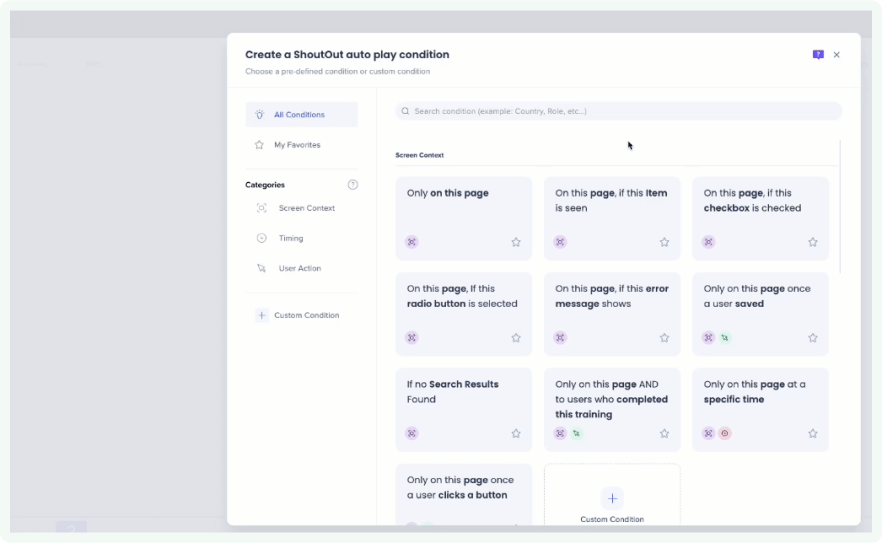
WalkMe vs. Pendo: Automation and workflow support
When it comes to automation and workflow support, WalkMe and Pendo offer different strengths.
WalkMe shines with its robust automation capability that is designed to accelerate business processes and streamline workflows. The platform provides powerful tools like Walk-Thrus, which are step-by-step guides that automate the process of training users on new software or features. WalkMe’s automation also extends to its SmartTips feature, which provides users with instant, contextual help without any human intervention. Furthermore, WalkMe’s Automation Anywhere feature is another stand-out offering, which allows businesses to automate any repetitive task or workflow, saving valuable time and resources.
In terms of workflow support, WalkMe’s dynamic walkthroughs can create adaptive sequences based on user actions and decisions, enabling a customized user experience. Its Task List feature allows businesses to create personalized task lists for users, guiding them through complex processes and ensuring nothing is missed. WalkMe’s Process Tracker also allows organizations to monitor user progress and identify bottlenecks, providing crucial insights to improve workflow efficiency.
Additionally, WalkMe supports complex business logic with customizable user workflow templates. Users can select the workflow aligned to their organizational needs, choose relevant tasks and customize their WalkMe in-app guidance content accordingly.
On the other hand, Pendo is well-regarded for its workflow support capabilities. Pendo’s Guides are a core feature of its platform, providing on-screen, step-by-step walkthroughs for users to efficiently navigate through complex processes or new features. These guides are easily customizable, allowing businesses to tailor the user experience based on specific roles, preferences, or behaviors.
Where Pendo falls a bit short is in its automation capabilities. While the platform does offer some automation in terms of guide delivery and user segmentation, it lacks the more advanced automation features found in WalkMe, such as task automation. However, Pendo’s analytics and data-driven approach offsets this somewhat, providing valuable insights that can be used to refine and optimize workflows.
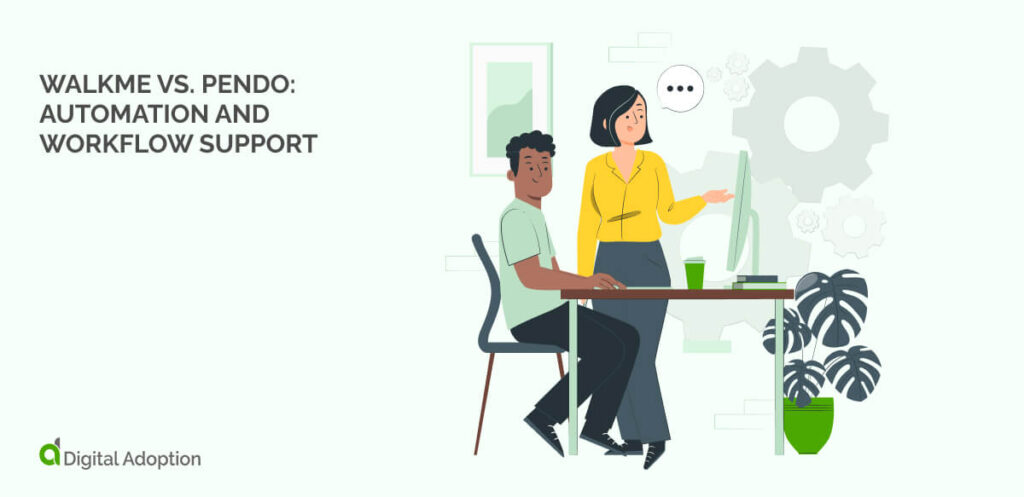
WalkMe vs. Pendo: Enterprise readiness
When it comes to enterprise readiness, both WalkMe and Pendo offer a host of features designed to meet the rigorous demands of large-scale operations.
WalkMe’s enterprise readiness is evident in its robust security framework, which includes ISO 27001 and SOC 2 Type II certifications, Fed-RAMP Ready status, GDPR compliance, and privacy by design. WalkMe’s high scalability allows it to handle large volumes of users and complex organizational structures, making it a suitable choice for large enterprises.
Additionally, WalkMe provides comprehensive integration capabilities, offering out-of-the-box integrations with leading business tools and custom API integrations to ensure seamless interoperability across your tech stack.
WalkMe also has an extensive partner network further underscoring its suitability for global enterprises. It collaborates with an array of technology partners, solution providers, and consulting partners to bolster its offering. These partnerships enhance WalkMe’s integration capabilities, extend its reach, and provide clients with additional resources and expertise. Regardless of your geographical location or specific business needs, this robust network ensures you can access and leverage WalkMe’s innovative technology effectively.
Pendo, on the other hand, also demonstrates strong commitment to enterprise readiness. Their platform is designed to scale with your business, supporting large user bases and complex product suites. Pendo’s security measures are robust, with compliance certifications including ISO 27001, SOC 2 Type II, GDPR, and the EU-US Privacy Shield. Like WalkMe, Pendo offers broad integration capabilities, supporting common business tools and offering API access for custom integrations. However, Pendo’s support offerings are reportedly less comprehensive than WalkMe’s, with some users noting slower response times and a lack of dedicated success managers.
In conclusion, both WalkMe and Pendo are well-equipped to handle the complex needs of large enterprises, with WalkMe possibly having a slight edge in terms of support and scalability.
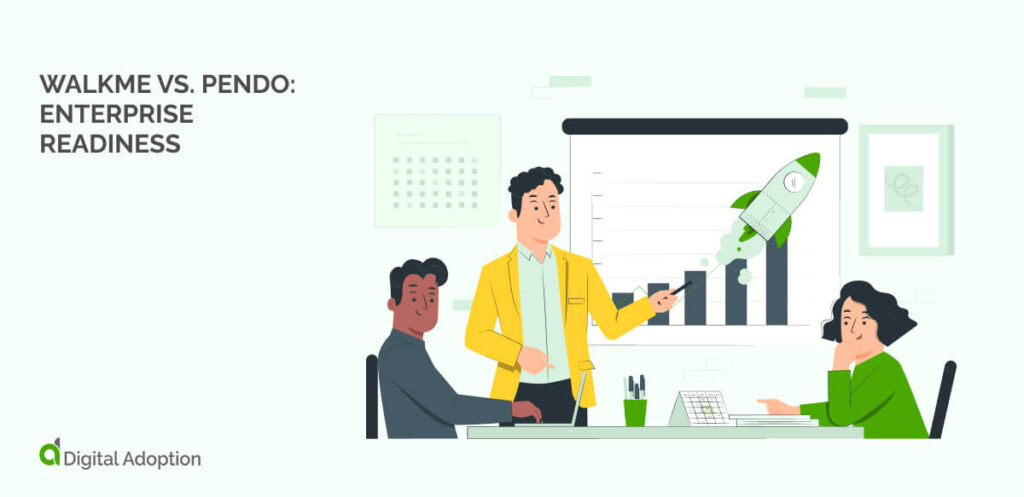
WalkMe vs. Pendo: Customer support and success
Customer support is a crucial element in maintaining user satisfaction and encouraging continuous engagement with the platform. Both WalkMe and Pendo offer customer support, but their respective offerings differ slightly.
WalkMe has a comprehensive customer success program, offering dedicated success managers. This personalized approach ensures that all customer issues are addressed promptly and efficiently. Additionally, WalkMe offers 24/7 support and a comprehensive knowledge base including extensive online documentation, webinars, and technical guides. WalkMe’s robust online community also provides an excellent platform for users to share insights, challenges, and solutions, fostering a sense of collaboration and community.
Pendo, on the other hand, provides a strong support framework, but reports suggest it is less extensive than WalkMe’s. Pendo offers email and chat support as well as an online knowledge base. However, some users have reported slower response times and a lack of dedicated success managers. Despite these criticisms, many users appreciate Pendo’s support for its helpfulness and responsiveness.
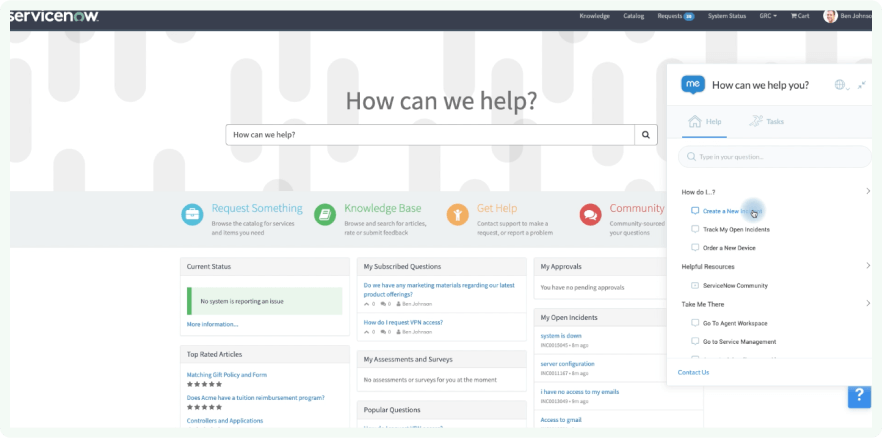
WalkMe vs. Pendo: Business value and ROI
When evaluating the business value and return on investment (ROI) of WalkMe and Pendo, there are several factors to consider:
WalkMe, with its robust set of features, provides significant business value. Its advanced automation capabilities can lead to substantial time savings for businesses, effectively increasing productivity levels and reducing operational costs. The platform’s detailed analytics can also provide valuable insights into user behavior, enabling businesses to optimize their software usage and improve overall user experience. These improvements can lead to higher customer satisfaction levels, increased customer retention, and ultimately, increased revenue.
In terms of ROI, WalkMe’s users often report a swift return on their investment. The efficiency gains from using the platform can lead to significant cost savings. Furthermore, businesses can expect increased revenue from improved customer satisfaction and engagement, further enhancing the ROI.
Pendo, on the other hand, also offers significant business value. Its detailed analytics on user interactions, behavior, and product usage can provide businesses with actionable insights to improve their product offerings and user experience. Furthermore, Pendo’s in-app guides and targeted messaging can enhance user onboarding and activation, leading to higher user engagement and retention.
In terms of ROI, Pendo’s users have also reported positive returns on their investment. The cost of the platform can often be justified by the improvements in product usage and customer retention. The data-driven insights provided by Pendo can also enable businesses to make informed decisions, leading to improved operational efficiency and potentially increased revenue.
Businesses seeking more advanced automation capabilities and personalized user experiences may find more value in WalkMe, while those prioritizing detailed user analytics and product usage insights may lean towards Pendo.
WalkMe vs. Pendo pricing comparison
WalkMe pricing structure
WalkMe offers two pricing packages, WalkMe for Employees and WalkMe for Customers. Both are designed to be flexible for accommodating any organization at any stage of the DAP maturity lifecycle as well as for easily picking the package of capabilities and pricing that’s right for them.
The WalkMe for Employees package includes a subscription model for the WalkMe Core offering with optional advanced add-on modules. This approach enables alignment between required features and corresponding pricing, where organizations that need only core features are not required to pay for additional DAP capabilities and functionality.
The WalkMe Core package includes analytics and reporting, interactive in-app guidance, unlimited user workflows, pre-built or bespoke, omnichannel experiences, and admin security controls including access management, privacy settings, and data hosting and residency.
Advanced add-on modules feature expanded DAP capabilities that extend the value of the Core package. Available modules include enterprise analytics, customization and collaboration, connected workplace, and enterprise security.
WalkMe for Customers is a package for customer facing applications. It includes advanced analytics and reporting, interactive in-app guides, tooltips, notifications, a self-serve content creation engine, smart audience targeting, enterprise-grade security, personalized onboarding and product tours, customer sentiment via NPS and surveys, and multi-language support, along with branding and white labeling.
WalkMe also offers a slimmed down, more affordable option called WalkMe Essentials. This is a package that comes at a fixed price with a fixed scope that is ready to roll out in four weeks. It includes up to two pre-built sales and HR workflows which are deployed for one of the following apps – Salesforce, Microsoft Dynamics, Workday, or SAP SuccessFactors, with professional services support.
Pendo pricing structure
Pendo offers custom pricing that is based on monthly active users (MAU). The company offers three packages – free, growth, and portfolio.
The free option includes product analytics, in-app guides, net promoter score (NPS), and roadmaps.
The Growth package is designed for use with a single web or mobile app, and includes product analytics, in-app guides, Net Promoter Score (NPS), roadmaps, and cross-app reports.
And the Portfolio package includes all that the Growth package offers but is meant for organizations with multiple products and can be used across unlimited web and mobile apps.
Among the features available in each are in-app guides, sentiment via NPS and surveys, and roadmaps, with the free plan available for 500 active monthly users, and growth and portfolio as a custom offering.
The WalkMe advantage: extending the value of DAP
WalkMe is the undisputed pioneer of DAP. With a transparent overlay it provides in-app guided tours and walkthroughs that assist users both internal and external users of enterprise software, home-grown applications, and digital tools, on any channel including desktop, mobile, and web.
It offers a feature set that is comprehensive, yet easy to manage for non-technical users. WalkMe also offers extensive customization options for addressing numerous user types and use cases.
One of the most widely appreciated benefits of WalkMe is how it extends the value and promise of DAP with unique features such as cross-app automation, cross-application analytics and insights, and an ActionBot that is powered by conversational automation.
The Pendo advantage: enhancing the product experience
For some companies ensuring a smooth product experience is the focus, rather than securing digital proficiency. This is where Pendo has found its niche. With an in-product resource center, a feedback solicitation tool, and the ability to categorize feedback, teams can garner insights on features and their usage and tweak as based on real-life user experiences.
Which is best for you?
Bottom line, which is best for you? As was noted in the beginning of the review, it all depends on what you need.
WalkMe is right for you if you have different types of users who need to be onboarded to numerous new apps and digital tools, or their new features, quickly and easily, and on an ongoing basis. WalkMe is also for you if you’re looking to gain clear, data-driven, and actionable insights into how you can maximize usage and optimize your software investments.
If on the other hand, you’re a mid-market organization or small business and are looking for a straightforward approach to enhancing the product experience, then Pendo is for you.
Not every organization has prioritized full-fledged digital adoption with extensive customization and analytics. If your KPIs are driven by how employees and customers experience a product, Pendo has what you need.
It’s also important to note that WalkMe has an extensive partner and peer ecosystem with an active global community of users and partners that provides insights, support, and resources.
Pendo’s smaller community and less established partnerships point to a less robust ecosystem compared to WalkMe.

WalkMe also outperforms in privacy and security. Comprehensive technical, contractual, and operational safeguards are applied, such as best-of-breed authentication, encryption, access control systems and configurations to protect against unauthorized access.
Also, unique to WalkMe is segmentation which enables presenting different content to users for various use cases, and personalization that enables users to deliver employee and customer experiences that drive action, with names displayed alongside a contextualized call to action.
In addition, with a library of pre-built templates based on industry best practices, the organization’s most critical workflows on the most popular business applications are easily automated. And ultimately, with patented native AI technology, WalkMe technology outperforms all other offerings.

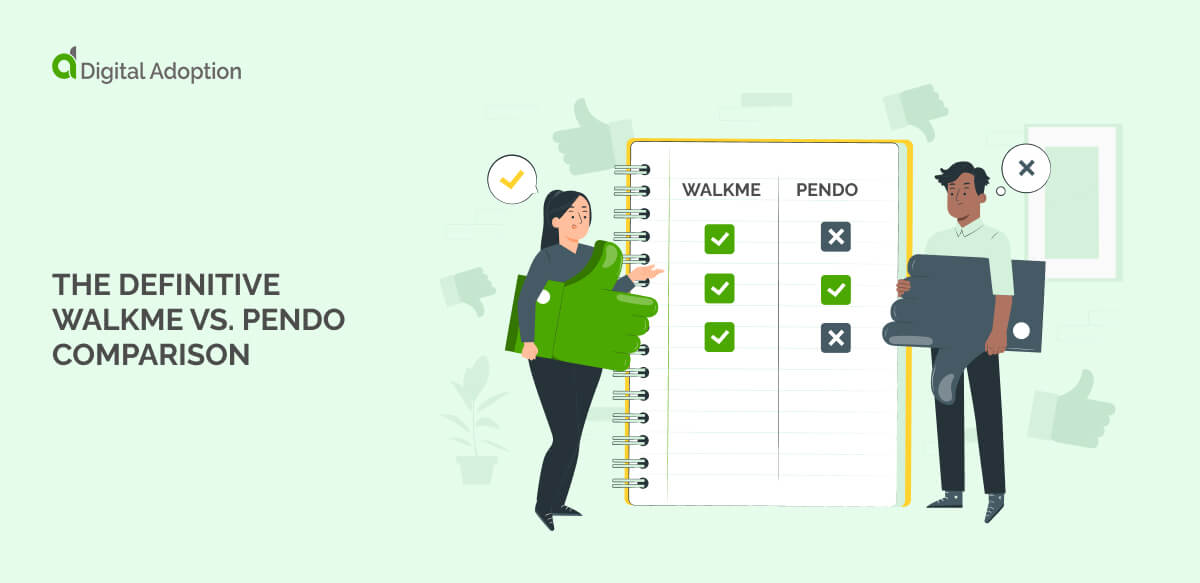

![18 Examples of AI in Finance [2025]](https://www.digital-adoption.com/wp-content/uploads/2025/06/18-Examples-of-AI-in-Finance-2025-300x146.jpg)
![14 Examples of AI in Manufacturing [2025]](https://www.digital-adoption.com/wp-content/uploads/2025/06/14-Examples-of-AI-in-Manufacturing-2025-300x146.jpg)
![29 Examples of AI in Education [2025]](https://www.digital-adoption.com/wp-content/uploads/2025/06/29-Examples-of-AI-in-Education-2025-300x146.jpg)
![15 Examples of AI in Retail [2025]](https://www.digital-adoption.com/wp-content/uploads/2025/06/15-Examples-of-AI-in-Retail-2025-300x146.jpg)
![13 Examples of AI in Healthcare [2025]](https://www.digital-adoption.com/wp-content/uploads/2025/06/AI-in-healthcare-examples-300x146.jpg)


![18 Examples of AI in Finance [2025]](https://www.digital-adoption.com/wp-content/uploads/2025/06/18-Examples-of-AI-in-Finance-2025.jpg)
![14 Examples of AI in Manufacturing [2025]](https://www.digital-adoption.com/wp-content/uploads/2025/06/14-Examples-of-AI-in-Manufacturing-2025.jpg)
![29 Examples of AI in Education [2025]](https://www.digital-adoption.com/wp-content/uploads/2025/06/29-Examples-of-AI-in-Education-2025.jpg)